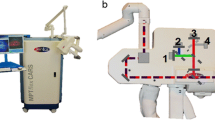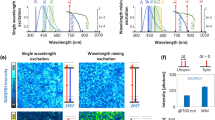ABSTRACT
Purpose
There is a lack of relevant, non-animal alternatives for assessing exposure and toxicity of nanoparticle-containing cosmetics, e.g. sunscreens. Our goal was to evaluate timecorrelated single photon counting (TCSPC) for simultaneous monitoring of zinc oxide nanoparticles (ZnO-NP) and the metabolic state of volunteer skin.
Methods
We separated the fluorescence lifetime signatures of endogenous fluorophore signals (i.e. nicotinamide adenine dinucleotide phosphate, NAD(P)H and keratin) and the ZnO-NP signal using advanced TCSPC to simultaneously determine ZnO-NP penetration profiles and NAD(P)H changes in subjects with altered barrier function, including tape-stripped skin and in psoriasis or atopic dermatitis lesions.
Results
We detected no ZnO-NP penetration into viable human skin in any group. ZnO-NP signal was significantly increased (p < 0.01) on the surface of tape-stripped and lesional skin after 4 and 2 h of treatment, respectively. Free NAD(P)H signal significantly increased in tape-stripped viable epidermis treated for 4 h of ZnO-NP compared to vehicle control. No significant NAD(P)H changes were noted in the lesional study.
Conclusion
TCSPC techniques enabled simultaneous, real-time quantification of ZnO-NP concentration and NAD(P)H via non-invasive imaging in the stratum corneum and viable epidermis of volunteers.






Similar content being viewed by others
Abbreviations
- AAS:
-
atomic absorption spectroscopy
- AU:
-
arbitrary unit
- CCT:
-
caprylic/capric triglycerides
- FLIM:
-
fluorescence lifetime imaging microscopy
- ICP-OES:
-
inductively coupled plasma-optical emission spectroscopy
- IRF:
-
instrument response function
- KDP:
-
potassium di-hydrogen phosphate
- MEP:
-
multiphoton-excited photoluminescence
- MPT:
-
multiphoton tomography
- MPT-FLIM:
-
multiphoton tomography with fluorescence lifetime imaging microscopy
- NAD(P)H:
-
nicotinamide adenine dinucleotide phosphate
- PBS:
-
phosphate-buffered saline
- SHG:
-
second harmonic generation
- TCSPC:
-
time-correlated single photon counting
- TEM:
-
transmission electron microscope
- TEWL:
-
transepidermal Water Loss
- Ti:Sa:
-
titanium:sapphire
- ZnO-NP:
-
zinc oxide nanoparticles
REFERENCES
DIRECTIVE 2003/15/EC OF THE EUROPEAN PARLIAMENT AND OF THE COUNCIL. Official Journal of the European Union 2003;46:26–35, .
Regulation (EC) No 1223/2009 of the European Parliament and of the Council of 30 November 2009 on cosmetic products Official Journal of the European Union. 52:59–209 (2009).
Ruet Rossignol M. The 7th Amendment to the Cosmetics Directive. Altern Lab Anim. 2005;33 Suppl 1:19–20.
Robertson TA, Sanchez WY, Roberts MS. Are commercially available nanoparticles safe when applied to the skin? J Biomed Nanotechnol. 2010;6:452–68.
Ahmed AH, Soyer HP, Saunders N, Boukamp P, Roberts MS. Non-melanoma skin cancers. Drug Discovery Today: Disease Mechanisms: Skin diseases. 2008;5:e55–62.
Leiterand U, Garbe C. Epidemiology of melanoma and nonmelanoma skin cancer–the role of sunlight. Adv Exp Med Biol. 2008;624:89–103.
Monteiro-Riviereand NA, Riviere JE. Interactions of nanomaterials with skin: Aspects of absorption and biodistribution. Nanotoxicology. 2009;3:188–95.
Nohynek GJ, Lademann J, Ribaud C, Roberts MS. Grey goo on the skin? Nanotechnology, cosmetic and sunscreen safety. Crit Rev Toxicol. 2007;37:251–77.
Singhand S, Nalwa HS. Nanotechnology and health safety–toxicity and risk assessments of nanostructured materials on human health. J Nanosci Nanotechnol. 2007;7:3048–70.
Sternand ST, McNeil SE. Nanotechnology safety concerns revisited. Toxicol Sci. 2008;101:4–21.
Cross SE, Innes B, Roberts MS, Tsuzuki T, Robertson TA, McCormick P. Human skin penetration of sunscreen nanoparticles: In-vitro assessment of a novel micronized zinc oxide formulation. Skin Pharmacol Phys. 2007;20:148–54.
Durand L, Habran N, Henschel V, Amighi K. In vitro evaluation of the cutaneous penetration of sprayable sunscreen emulsions with high concentrations of UV filters. Int J Cosmet Sci. 2009;31:279–92.
Newman MD, Stotland M, Ellis JI. The safety of nanosized particles in titanium dioxide- and zinc oxide-based sunscreens. J Am Acad Dermatol. 2009;61:685–92.
Roberts MS, Roberts MJ, Robertson TA, Sanchez W, Thorling C, Zou Y, et al. In vitro and in vivo imaging of xenobiotic transport in human skin and in the rat liver. J Biophotonics. 2008;1:478–93.
Kortingand HC, Schafer-Korting M. Carriers in the topical treatment of skin disease. Handb Exp Pharmacol :435–468 (2010).
Prow TW, Grice JE, Lin LL, Faye R, Butler MK, Becker W, Wurme EMT, Yoong Y, Robertsona TA, Soyer HP, Roberts MS. Nanoparticles and Microparticles for Skin Drug Delivery. Adv Drug Del Rev:In press. (2011).
Schneider M, Stracke F, Hansen S, Schaefer UF. Nanoparticles and their interactions with the dermal barrier. Dermatoendocrinol. 2009;1:197–206.
Zhangand LW, Monteiro-Riviere NA. Assessment of quantum dot penetration into intact, tape-stripped, abraded and flexed rat skin. Skin Pharmacol Phys. 2008;21:166–80.
Samberg ME, Oldenburg SJ, Monteiro-Riviere NA. Evaluation of silver nanoparticle toxicity in skin in vivo and keratinocytes in vitro. Environ Health Perspect. 2010;118:407–13.
Kuo TR, Wu CL, Hsu CT, Lo W, Chiang SJ, Lin SJ, et al. Chemical enhancer induced changes in the mechanisms of transdermal delivery of zinc oxide nanoparticles. Biomaterials. 2009;30:3002–8.
Bian SW, Mudunkotuwa IA, Rupasinghe T, Grassian VH. Aggregation and Dissolution of 4 nm ZnO Nanoparticles in Aqueous Environments: Influence of pH, Ionic Strength, Size, and Adsorption of Humic Acid. Langmuir (2011).
Gamer AO, Leibold E, van Ravenzwaay B. The in vitro absorption of microfine zinc oxide and titanium dioxide through porcine skin. Toxicology in Vitro. 2006;20:301–7.
Gulson B, McCall M, Korsch M, Gomez L, Casey P, Oytam Y, et al. Small amounts of zinc from zinc oxide particles in sunscreens applied outdoors are absorbed through human skin. Toxicol Sci. 2010;118:140–9.
Zvyagin AV, Zhao X, Gierden A, Sanchez W, Ross JA, Roberts MS. Imaging of zinc oxide nanoparticle penetration in human skin in vitro and in vivo. J Biomed Opt. 2008;13:064031.
Sanchez WY, Prow TW, Sanchez WH, Grice JE, Roberts MS. Analysis of the metabolic deterioration of ex vivo skin from ischemic necrosis through the imaging of intracellular NAD(P)H by multiphoton tomography and fluorescence lifetime imaging microscopy. J Biomed Opt. 2010;15:046008.
Ying W. NAD+/NADH and NADP+/NADPH in cellular functions and cell death: regulation and biological consequences. Antioxid Redox Signal. 2008;10:179–206.
Becker W. Advanced time-correlated single photon counting techniques. Berlin: Springer; 2005.
Berg JM, Romoser A, Banerjee N, Zebda R, Sayes CM. The relationship between pH and zeta potential of similar to 30 nm metal oxide nanoparticle suspensions relevant to in vitro toxicological evaluations. Nanotoxicology. 2009;3:276–83.
Prow TW, Monteiro-Riviere NA, Inman AO, Grice JE, Chen X, Zhao X, Sanchez WH, Gierden A, Kendall MA, Zvyagin AV, Erdmann D, Riviere JE, Roberts MS. Quantum dot penetration into viable human skin. Nanotoxicology 2011.
ACKNOWLEDGMENTS & DISCLOSURES
We would like to thank the National Health and Medical Research Council of Australia (ID# 569694) and the United States Air Force Asian Office of Aerospace Research and Development for funding. We also thank Corinne Yoong for recruiting volunteers for the lesion studies.
Author information
Authors and Affiliations
Corresponding author
Rights and permissions
About this article
Cite this article
Lin, L.L., Grice, J.E., Butler, M.K. et al. Time-Correlated Single Photon Counting For Simultaneous Monitoring Of Zinc Oxide Nanoparticles And NAD(P)H In Intact And Barrier-Disrupted Volunteer Skin. Pharm Res 28, 2920–2930 (2011). https://doi.org/10.1007/s11095-011-0515-5
Received:
Accepted:
Published:
Issue Date:
DOI: https://doi.org/10.1007/s11095-011-0515-5




